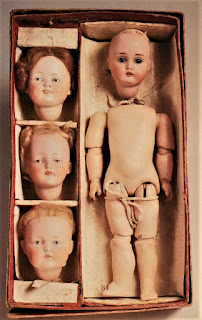In a question and answer session, Ra'chel Ba'ucham, who creates dolls under the brand, Creations by Ba'ucham, shares her artist profile with the readers of Ebony-Essence of Dolls in Black.
__________
How long have you been making dolls and what inspired you to begin making them?
I have been making dolls for about 3 years in my spare time, while I worked as a full-time nurse. What inspired me was a dream that I had that God had gifted me with the gift of doll making, even though at that time I had never made a doll in my life.
 |
| The first crocheted boy doll by Creations by Ba'ucham, Roger, is shown with the artist's second crocheted girl, whose name is Ariana. |
What is your favorite medium or favorite media, if more than one and why?
I love working with all mediums, from fabric, clay, seeds, beads, shells and even sticks. I up-cycle some dolls from simple things like empty coffee creamer containers, really any medium that calls out to me to be re-invented.
Do you have your own personal style or trademark that sets your dolls apart from other dolls made from the medium/media that you use?
Each doll that I craft is unique in that they are truly one of a kind. Each doll is authenticated with a unique marking known only to myself and one other person. Each doll is further supported by copyright documentation registered in the Library of Congress, assuring each doll owner that they are in possession of an authentic doll crafted by me, the artist and designer. Each doll receives a Certificate of Authenticity and there is only one like each doll in the whole world. No patterns are used in the crafting of my dolls, no matter what medium that is used.
Do your dolls direct your path during the creation process in determining their final appearance?
Yes, and only another doll maker would understand that each doll has a personality all unique to them. They will advise me as to how they want to be presented. They advise me in every step of their creative journey from hairstyle, facial expression, clothing, accessories, and name.
Do you want collectors to gain a sense of realism from your dolls, or are your dolls abstract characters?
Yes, realism. Each doll is an extension on me, and expresses the multifaceted layers of my own personality, from the little girl to the mature woman that I am, and the whole width and depth of uncharted territory in-between the two facets.
Describe your latest doll creation and the inspiration.
My latest creation is a little boy doll. His name is Bernard. He operates in the personality of a two-year-old child and my inspiration was influenced by a dear friend of mine whose name is Bernard. My friend is 61 years old, but at times the little boy in him surfaces and thus his mini-me was crafted.
Do you have any tips for aspiring artists?
I am still fresh on this journey but would offer that everyone reach deep within themselves and craft from their soul. There are a lot of doll makers but so are there many hamburger restaurants – each one offers the community a different take on the same medium. So don't be intimidated. There is enough of God, His gifts, and His love to fill everyone's cup in this world, and there would still be overage. Be your true authentic self, and explore your own unique flavor and believe that you are in possession of that unique one-of-a-kind spice that the world needs to experience.
 | |
|
The prices vary. They mostly range from $80 to $155 depending on the complexity to make them.
How can you be reached?
Creations by Ba'ucham
Ra'chel Ba'ucham Artist/Designer
E-mail: unekleyme1010@gmail.com
Facebook: https://www.facebook.com/CreationsbyBaucham/Etsy: https://www.etsy.com/shop/CreationsByBaucham
__________
Ebony-Essence of Dolls in Black extends a heartfelt thanks to Ra'chel for taking the time to share her artist profile and the images of her one-of-a-kind, handcrafted doll designs. Visit the Black Doll Collecting blog to see a detailed review of one of Ra'chel's freehand crocheted dolls.





















